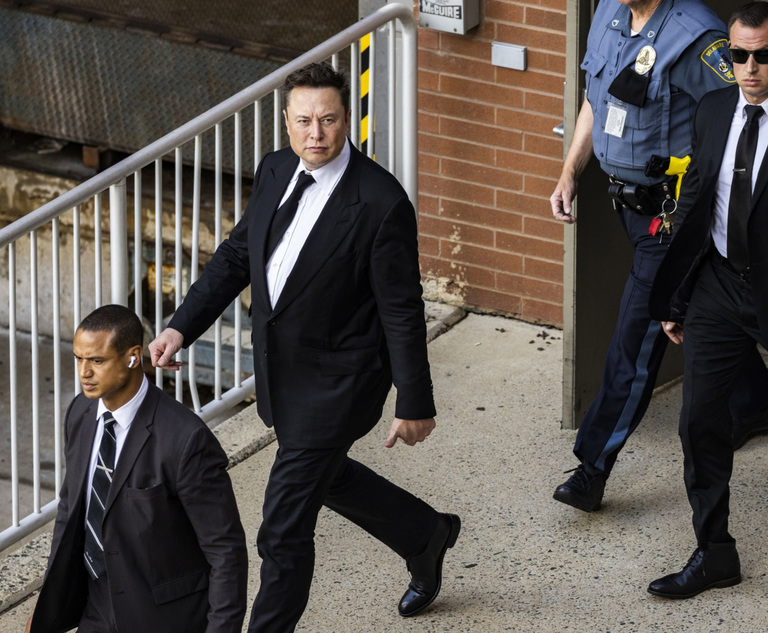Musk Gets a Question In From the Witness Stand in 'Funding Secured' Securities Trial
In a securities case accusing Musk of lying about securing funds to take Tesla private, he asked a lawyer for the plaintiffs about efforts to subpoena a Saudi official who might be able to answer questions about the deal.
January 24, 2023 at 07:30 AM
4 minute read
The original version of this story was published on Litigation Daily
 Elon Musk, chief executive officer of Tesla Inc., center, departs from court for the SolarCity trial in Wilmington, Delaware, U.S., on Monday, July 12, 2021. Photo: Samuel Corum/Bloomberg
Elon Musk, chief executive officer of Tesla Inc., center, departs from court for the SolarCity trial in Wilmington, Delaware, U.S., on Monday, July 12, 2021. Photo: Samuel Corum/Bloomberg
We hope you enjoy this excerpt from Litigation Daily, the exclusive source for sharp commentary on mega court battles, winning strategies and the issues that obsess elite litigators. Law.com subscribers can sign up for The AmLaw Litigation Daily newsletter here. Anyone else can click here to subscribe.
Judges often strike the most interesting exchanges between lawyers and witnesses from the trial record—especially those where the witness starts asking the questions.
That was certainly the case Monday as Elon Musk took the stand for his second day on the stand in the trial centering on his 2018 tweets announcing plans to take Tesla private. Musk began testifying late Friday afternoon in the rare securities class action to make it to trial after being called as an adverse witness by Nicholas Porritt of Levi & Korsinsky who represents a class of thousands of Tesla shareholders. Plaintiffs claim their Tesla stock lost millions—possibly billions—in value after Musk tweeted on Aug. 7, 2018: "Am considering taking Tesla private at $420. Funding secured."
Senior U.S. District Judge Edward Chen in San Francisco found last year that the tweet was reckless and false as well as a follow-up tweet Musk sent just hours later saying: "Investor support is confirmed. Only reason why this is not certain is that it's contingent on a shareholder vote." Jurors are set to decide whether those statements were material to investors and, if so, what damage they did to the stock value.
This content has been archived. It is available through our partners, LexisNexis® and Bloomberg Law.
To view this content, please continue to their sites.
Not a Lexis Subscriber?
Subscribe Now
Not a Bloomberg Law Subscriber?
Subscribe Now
NOT FOR REPRINT
© 2025 ALM Global, LLC, All Rights Reserved. Request academic re-use from www.copyright.com. All other uses, submit a request to [email protected]. For more information visit Asset & Logo Licensing.
You Might Like
View All
Miami Judge Approves Shaq's $11 Million Settlement to Resolve Astrals Investor Claims
3 minute read

Semiconductor Component Maker Accused of Deceiving Investors About Market Downturn, Export Curbs
3 minute read
Law Firms Mentioned
Trending Stories
- 1US Judge Dismisses Lawsuit Brought Under NYC Gender Violence Law, Ruling Claims Barred Under State Measure
- 24th Circuit Upholds Virginia Law Restricting Online Court Records Access
- 3Lawsuit Against Major Food Brands Could Be Sign of Emerging Litigation Over Processed Foods
- 4Fellows LaBriola LLP is Pleased to Announce that Alisha Goel Has Become Associated with The Firm
- 5Law Firms Turn to 'Golden Handcuffs' to Rein In Partner Movement
Who Got The Work
J. Brugh Lower of Gibbons has entered an appearance for industrial equipment supplier Devco Corporation in a pending trademark infringement lawsuit. The suit, accusing the defendant of selling knock-off Graco products, was filed Dec. 18 in New Jersey District Court by Rivkin Radler on behalf of Graco Inc. and Graco Minnesota. The case, assigned to U.S. District Judge Zahid N. Quraishi, is 3:24-cv-11294, Graco Inc. et al v. Devco Corporation.
Who Got The Work
Rebecca Maller-Stein and Kent A. Yalowitz of Arnold & Porter Kaye Scholer have entered their appearances for Hanaco Venture Capital and its executives, Lior Prosor and David Frankel, in a pending securities lawsuit. The action, filed on Dec. 24 in New York Southern District Court by Zell, Aron & Co. on behalf of Goldeneye Advisors, accuses the defendants of negligently and fraudulently managing the plaintiff's $1 million investment. The case, assigned to U.S. District Judge Vernon S. Broderick, is 1:24-cv-09918, Goldeneye Advisors, LLC v. Hanaco Venture Capital, Ltd. et al.
Who Got The Work
Attorneys from A&O Shearman has stepped in as defense counsel for Toronto-Dominion Bank and other defendants in a pending securities class action. The suit, filed Dec. 11 in New York Southern District Court by Bleichmar Fonti & Auld, accuses the defendants of concealing the bank's 'pervasive' deficiencies in regards to its compliance with the Bank Secrecy Act and the quality of its anti-money laundering controls. The case, assigned to U.S. District Judge Arun Subramanian, is 1:24-cv-09445, Gonzalez v. The Toronto-Dominion Bank et al.
Who Got The Work
Crown Castle International, a Pennsylvania company providing shared communications infrastructure, has turned to Luke D. Wolf of Gordon Rees Scully Mansukhani to fend off a pending breach-of-contract lawsuit. The court action, filed Nov. 25 in Michigan Eastern District Court by Hooper Hathaway PC on behalf of The Town Residences LLC, accuses Crown Castle of failing to transfer approximately $30,000 in utility payments from T-Mobile in breach of a roof-top lease and assignment agreement. The case, assigned to U.S. District Judge Susan K. Declercq, is 2:24-cv-13131, The Town Residences LLC v. T-Mobile US, Inc. et al.
Who Got The Work
Wilfred P. Coronato and Daniel M. Schwartz of McCarter & English have stepped in as defense counsel to Electrolux Home Products Inc. in a pending product liability lawsuit. The court action, filed Nov. 26 in New York Eastern District Court by Poulos Lopiccolo PC and Nagel Rice LLP on behalf of David Stern, alleges that the defendant's refrigerators’ drawers and shelving repeatedly break and fall apart within months after purchase. The case, assigned to U.S. District Judge Joan M. Azrack, is 2:24-cv-08204, Stern v. Electrolux Home Products, Inc.
Featured Firms
Law Offices of Gary Martin Hays & Associates, P.C.
(470) 294-1674
Law Offices of Mark E. Salomone
(857) 444-6468
Smith & Hassler
(713) 739-1250






